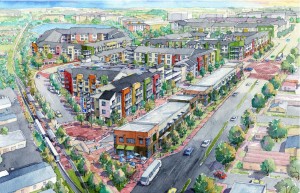California is raking in the bucks from its cap-and-trade program. Sales from auctioning off permits to pollute will net the state close to $900 million in this budget year, and it could go to $8 billion a year by 2020, now that transportation fuels are firmly under the cap. Of that amount, about half is dedicated to transportation and infill development that can reduce greenhouse gas emissions. Here is the breakdown on that piece of it:
Transit Capital: $25 million (10% of total auction revenue)
Transit Operations: $25 million (5% of total revenue)
Housing & Sustainable Communities: $130 million (20%)
High Speed Rail: $250 million (25%)
The rest will go to wetland restoration, energy efficiency upgrades for public buildings, and recycling efforts.
 But it’s that $130 million piece that’s been in the news recently (it’s actually $120 million, due to an additional $10 million set-aside for agricultural projects). Called the Affordable Housing and Sustainable Communities (AHSC) Program, state agencies have been trying to adopt the guidelines for disbursing these funds for meritorious land use and transportation projects for over a year. That process was finalized a few weeks ago by the Strategic Growth Council, which issued a complicated set of criteria for project proponents to be eligible to apply.
But it’s that $130 million piece that’s been in the news recently (it’s actually $120 million, due to an additional $10 million set-aside for agricultural projects). Called the Affordable Housing and Sustainable Communities (AHSC) Program, state agencies have been trying to adopt the guidelines for disbursing these funds for meritorious land use and transportation projects for over a year. That process was finalized a few weeks ago by the Strategic Growth Council, which issued a complicated set of criteria for project proponents to be eligible to apply.
According to the new guidelines [PDF], half of the funded projects must provide affordable housing near transit, while the other half must provide benefits for “disadvantaged communities,” per this map.
But the problem is (at least for this first round), $120 million won’t get you very far. Affordable housing projects have a minimum grant award of $1 million and maximum of $15 million, while transit projects in disadvantaged communities have a minimum $500 thousand and maximum $8 million. You can see how that money will go quickly with only $120 million to disburse. As Streetsblog LA reported, Strategic Growth Council staff “expect to be able to fund between 15 and 25 projects in the first round.”
15 to 25 projects is, frankly, not much. And not much to get excited about in this first round. Fortunately, more money will be available later this year in the second round, and an expanding pot of auction funds could mean almost 10 times this amount in a few years, if the $8 billion-by-2020 projection comes true.
But even at 10 times this amount (over $1 billion a year), that’s just a couple hundred projects per year — not enough to make up for the loss of redevelopment funds. These funds were a primary source of infill financing, and the program netted about $5 billion annually statewide until it self-immolated in a 2011 California Supreme Court case.
I hate to be a Debbie Downer, but California will need to do better than this given the extreme housing needs in the state. It’s hard not to look jealously at the high speed rail set-aside and wonder why more of that money is not flowing to transit-oriented housing. After all, high speed rail was sold as a viable public-private investment that would essentially pay for itself. But after voter approval, the route was politically gerrymandered to accommodate powerful political interests. The politically motivated route changes to Palmdale and the eastern San Joaquin Valley drove up the price tag due to more complicated construction, reduced travel speeds between the major population centers, and made the project less attractive to private investors.
Perhaps as more constituents get a taste of cap-and-trade dollars, it will put political pressure on Sacramento leaders to retool the formulas to give more money to transit-oriented housing. It won’t happen while Governor Brown is in office, given his attachment to high speed rail as a legacy project, but I wouldn’t be surprised if it happens before 2020.
Leave a Reply
You must be logged in to post a comment.


